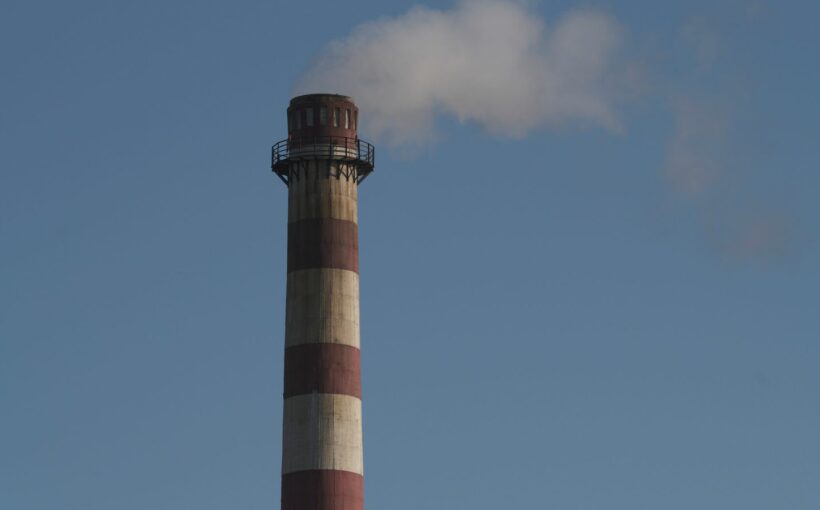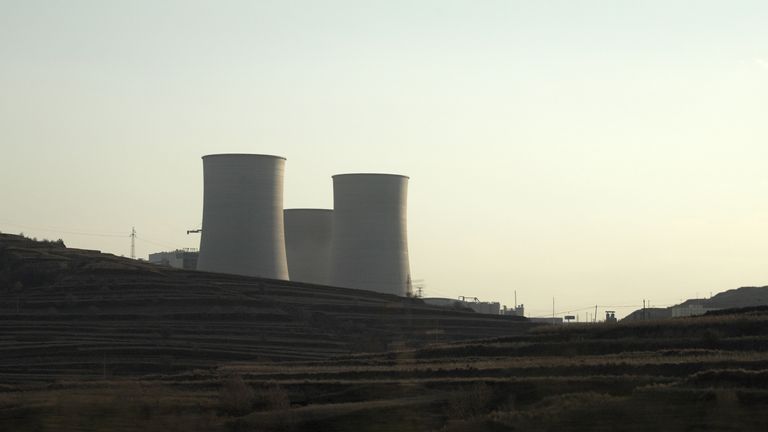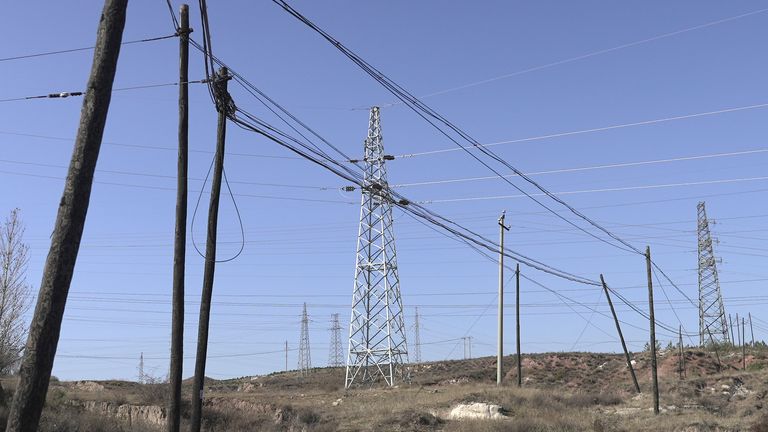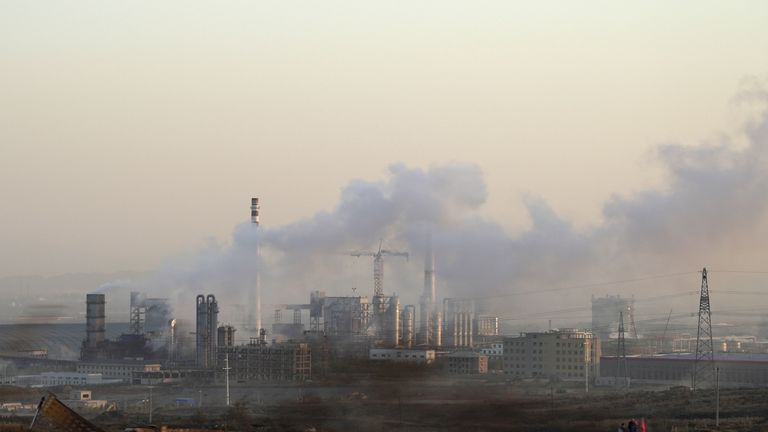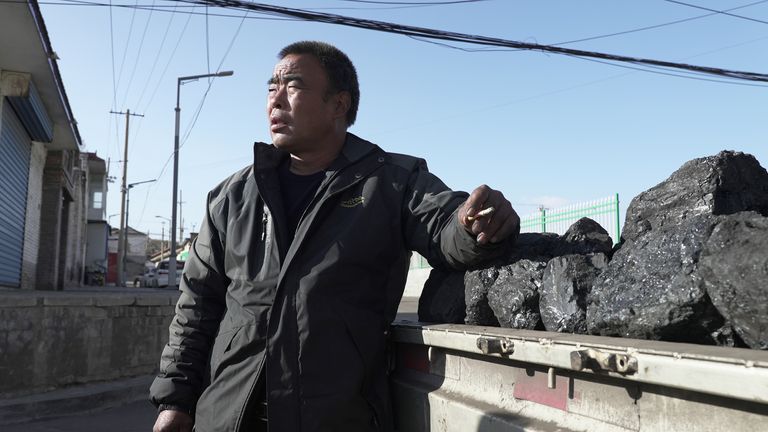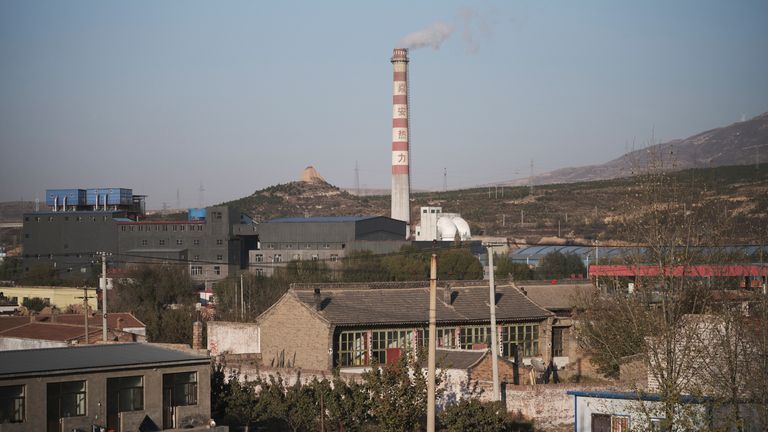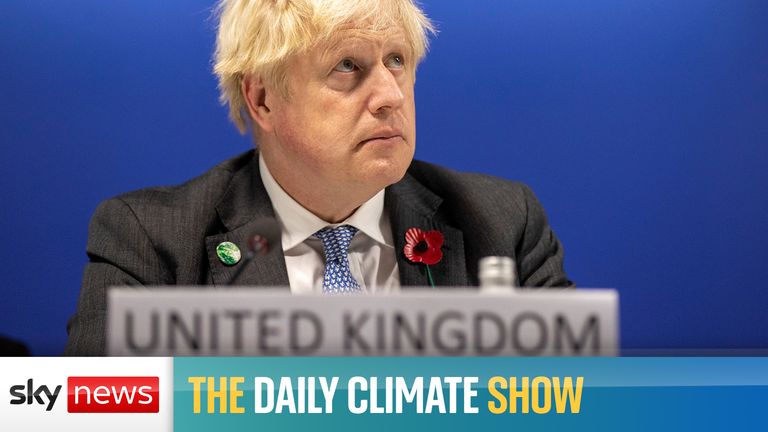The skies above Shanxi are bright blue and almost everything on the ground is caked in soot and grime.
This is China’s coal country. And what happens here affects the whole climate.
Coal is the dirtiest fossil fuel around and China burns more of it than the rest of the world combined – and it’s only speeding up.
Follow live coverage from COP26
We took a road trip to this northern province to see for ourselves. As much of the world is moving away from coal, it feels like China is only doubling down. Coal shortages left much of this country without power earlier this year, and they are making up the difference with gusto.
We see literally hundreds of trucks carrying coal from mines to power stations, or further afield in China. They thunder along the roads.
There are vast open surface coal mines, noisy with trucks and diggers and the dull thump of explosions as more coal is shaken out of the ground.
Mao-era power stations are apparently still in operation, with giant socialist slogans carved into the rock face alongside.
But it’s the new, state-of-the art coal-fired power stations that we’ve come to see.
We visit three power stations a few hours’ drive from each other, all in the orbit of Shuozhou, an industrial town seven hours drive from Beijing.
Two of them are brand new and still under construction. The third is an existing power plant that is adding extra capacity.
Those three power plants alone represent more coal power than the UK’s entire output – and they nearly weren’t even built.
All three projects were halted due to a nationwide order in 2017 to restrict coal power. But they are all underway once more.
This is zombie coal power: killed off, then brought stumbling back to life. China seemingly can’t – or won’t – finish them off for good.
And what we see in Shanxi isn’t about the gap between pledges and reality, between high level international summits and the truth on the ground.
What we see here is that pledge, the officially announced target. China plans to keep adding coal power for the next four years, and after that only reduce it “gradually”.
Ahead of COP26, it argued that coal use should be reduced, but not at the expense of energy security or political stability.
Before our road trip, back in Beijing, Sun Zhen, the deputy chief of China’s climate change department, told me that “as a developing country, China is currently facing the arduous tasks of developing the economy, improving people’s livelihood, eradicating poverty, and maintaining national security.
“There are still many practical difficulties and challenges in adjusting the energy structure, which cannot be accomplished overnight,” he said.
It may strike you as special pleading from what is the world’s second-biggest economy. But you can see those challenges in Ningwu, a town attached to one of the new coal power plants we visit.
It is a busy place on a Sunday afternoon, with old men playing cards in the street and younger people queuing for street snacks. An elevated rail track runs over the main street, bearing a seemingly endless coal train.
In a backstreet, we come across a small pickup van, its open back loaded with big chunks of coal.
The driver is called Fan Laosi. He’s in his 50s and smokes cigarettes relentlessly. His hands are sooty and so are his eyes, to the extent that it looks like eyeshadow.
“I’m waiting here by a school because more people pass by,” he explains. “My whole family sells coal. My son, my daughter and I, we’ve sold coal our whole lives.”
We ask him if he knows about China’s emissions targets, or COP26.
“No, I don’t know. I’m busy every day. I earn my life by working outside all day long.”
He says that the skies above Ningwu have always been as blue as they are today, and he hasn’t seen any changes in the air or the climate generally.
The surge in coal prices has made his life more difficult, though. Previously he would drive to nearby mines to load up. Now he sometimes has to wait two days for whatever is spare. He can sell two van loads of coal for 300 RMB, about 34 GBP.
Two customers come. They haven’t heard about COP26 either. One of them, an old man, isn’t buying today. He stockpiled before the price surge and looks proud of that.
Given the nature of the Chinese political system, many assume that if the leadership wanted to be greener, it could just make it happen. But there are real difficulties in that, especially for people like Fan Laosi, whose livelihood depends on coal.
And it’s possible to point, fairly, to other factors in China’s defence. No country has invested more or has more capacity in renewable energy like wind and solar. And its per capita emissions are still much lower than the US and Canada, and even Germany.
Chinese climate experts argue that it’s not practical for China to move faster.
Wang Jun is a carbon consultant who has spent years working with companies to help them lower their admissions, even writing a book on the subject.
Over a video call, he argues: “You can’t reduce coal from tomorrow. It’s impossible. So many industries need power – where does that power come from?
“I think the government targets are reasonable. We can’t let people suffer coldness and starvation now because of climate change. It’s unreasonable.”
But others argue China is simply not willing to accept the economic pain of reducing its emissions.
Christine Shearer is the program director for coal at Global Energy Monitor, a US-based NGO.
“The central government can be very powerful when it wants to be and we have seen that on a host of issues,” she tells me via Zoom.
“Clearly it’s reluctant to rein in coal plant building and I think that stems from concerns about a slowdown in economic growth.”
Subscribe to ClimateCast on Spotify or Apple Podcasts.
China has modified its approach, though, she points out.
“What we’ve really seen is that it’s narrowing down to a handful or provinces – and it’s provinces that have really become dependent on coal for jobs, projects, and for meeting economic targets.”
Shanxi is one of those provinces, along with its neighbours Shaanxi and Inner Mongolia, which all sit on the same rich seam of coal.
The view on the ground is depressing. But it is not fixed or final.
Coal emissions will be added until 2025, true, but it depends on the shape of China’s coal peak. If it can reduce that more quickly, rather than “gradually”, the world will be in a much better place.
The language is still vague – and that represents an opportunity for other countries to add pressure, especially perhaps at COP 26, for China to reduce emissions quicker.
It requires a will that has so far been lacking.
And in that uncertainty, that hesitation, hangs the future of our climate.
For full coverage of COP26, watch Climate Live on Sky channel 525.
Follow live coverage on web and app with our dedicated live blog.
Get all the latest stories, special reports and in-depth analysis at skynews.com/cop26
Source: Read Full Article
